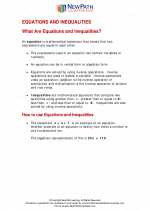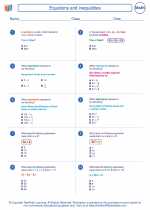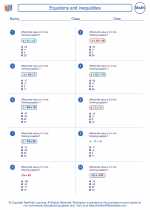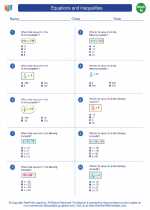Equations
An equation is a mathematical statement that shows the equality of two expressions. It typically contains an unknown variable that we need to solve for. The goal when working with equations is to find the value of the variable that makes the equation true.
Linear Equations
A linear equation is an equation of the first degree, which means the highest exponent of the variable is 1. The general form of a linear equation is ax + b = c, where a, b, and c are constants, and x is the variable we're solving for.
To solve a linear equation, we use properties of equality to isolate the variable on one side of the equation. This typically involves performing the same operation on both sides of the equation to maintain equality.
Quadratic Equations
A quadratic equation is an equation of the second degree, which means the highest exponent of the variable is 2. The general form of a quadratic equation is ax^2 + bx + c = 0, where a, b, and c are constants, and x is the variable we're solving for.
To solve a quadratic equation, we can use methods such as factoring, completing the square, or using the quadratic formula.
Inequalities
An inequality is a mathematical statement that shows the relationship between two expressions, typically using symbols such as < (less than), > (greater than), ≤ (less than or equal to), or ≥ (greater than or equal to).
Linear Inequalities
A linear inequality is similar to a linear equation, but instead of an equal sign, it contains an inequality symbol. The general form of a linear inequality is ax + b < c or ax + b > c, where a, b, and c are constants, and x is the variable.
To solve a linear inequality, we use similar techniques as solving linear equations, but we need to pay attention to the direction of the inequality when performing operations.
Quadratic Inequalities
A quadratic inequality is an inequality that contains a quadratic expression. These can be more complex to solve than linear inequalities and often require graphing techniques or algebraic manipulation to find the solution set.
Study Tips
- Practice solving equations and inequalities using a variety of methods.
- Understand the properties of equality and inequality and how they apply to different algebraic expressions.
- Work on word problems involving equations and inequalities to see real-world applications of these concepts.
- Use graphing techniques to visualize solutions to inequalities and understand how they relate to number lines.
- Review different methods for solving quadratic equations and inequalities, such as factoring, completing the square, and using the quadratic formula.
[Equations And Inequalities] Related Worksheets and Study Guides:
.◂Math Worksheets and Study Guides Eighth Grade. Equations and inequalities

 Worksheet/Answer key
Worksheet/Answer key
 Worksheet/Answer key
Worksheet/Answer key
 Worksheet/Answer key
Worksheet/Answer key
